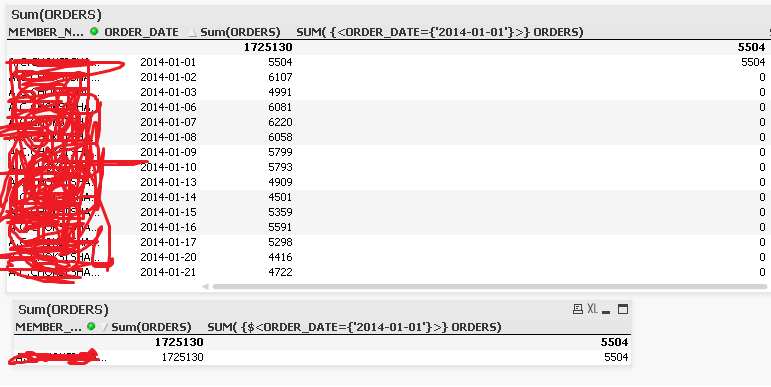Unlock a world of possibilities! Login now and discover the exclusive benefits awaiting you.
- Qlik Community
- :
- All Forums
- :
- QlikView App Dev
- :
- General Question on SET Analysis- Limitation
- Subscribe to RSS Feed
- Mark Topic as New
- Mark Topic as Read
- Float this Topic for Current User
- Bookmark
- Subscribe
- Mute
- Printer Friendly Page
- Mark as New
- Bookmark
- Subscribe
- Mute
- Subscribe to RSS Feed
- Permalink
- Report Inappropriate Content
General Question on SET Analysis- Limitation
I have observe that when we use SET Analysis we mostly use the Column which is not part of the table Dimension ( table Column). For example if i have a Date Field on particular table and Date is part of table Dimension then if we want to use some SET Analysis based Expression and want Date Dimension ( Field) to be the condition.
If we do so then i found its not work as per the standard, but if we replace the Date Dimension to any other Dimension like Client Name, Address or any except the Field which is in SET Analysis its work as per the standard.
Can anyone have any idea why it is so ? or what is the best way to do so..
- Tags:
- set-analysis
Accepted Solutions
- Mark as New
- Bookmark
- Subscribe
- Mute
- Subscribe to RSS Feed
- Permalink
- Report Inappropriate Content
As I see it, QlikView is doing the right thing.
Both charts show that
Sum(ORDERS) = 1725130
Sum({<ORDER_DATE={'2014-01-01'}>} ORDERS) = 5504
When you add ORDER_DATE as dimension, the above numbers will be distributed over the dates, each dollar assigned to the proper date. So of course, you get 0 for all dates but one.
If you instead want every line to have 5504 on it, you need to use the total qualifier, e.g.
Sum({<ORDER_DATE={'2014-01-01'}>} total ORDERS)
or
Sum({<ORDER_DATE={'2014-01-01'}>} total <MEMBER_N...> ORDERS)
depending on which number you want (total over all MEMBER_Ns or total within each MEMBER_N)
HIC
See also
- Mark as New
- Bookmark
- Subscribe
- Mute
- Subscribe to RSS Feed
- Permalink
- Report Inappropriate Content
It does not matter whether the field in the Set modifier is used as dimension or not. The Set modifier works the same way in both cases.
If you have a case where you think that the Set Analysis isn't evaluated correctly, then please post an example that shows this.
HIC
- Mark as New
- Bookmark
- Subscribe
- Mute
- Subscribe to RSS Feed
- Permalink
- Report Inappropriate Content
Dear Henric,
Below is my sample Report
when i create a tabular Report like Memberwise sum(Orders) and Sum(orders) of specific Date its work fine. ( See bottom one record table. its showing sum of orders and third column showing orders on particular date.
but when i just add order_date as dimension into the table its did not work as per need. means each datewise record i want 4th column should be the sum of the date which i have used in the filter.

- Mark as New
- Bookmark
- Subscribe
- Mute
- Subscribe to RSS Feed
- Permalink
- Report Inappropriate Content
As I see it, QlikView is doing the right thing.
Both charts show that
Sum(ORDERS) = 1725130
Sum({<ORDER_DATE={'2014-01-01'}>} ORDERS) = 5504
When you add ORDER_DATE as dimension, the above numbers will be distributed over the dates, each dollar assigned to the proper date. So of course, you get 0 for all dates but one.
If you instead want every line to have 5504 on it, you need to use the total qualifier, e.g.
Sum({<ORDER_DATE={'2014-01-01'}>} total ORDERS)
or
Sum({<ORDER_DATE={'2014-01-01'}>} total <MEMBER_N...> ORDERS)
depending on which number you want (total over all MEMBER_Ns or total within each MEMBER_N)
HIC
See also
- Mark as New
- Bookmark
- Subscribe
- Mute
- Subscribe to RSS Feed
- Permalink
- Report Inappropriate Content
Hi Henric,
Thanks you very much Man, i was struggling on this from 2-3 Days, i can't express my feeling you have solved my very big issue..
Thanks once again
Thanks & Regards,